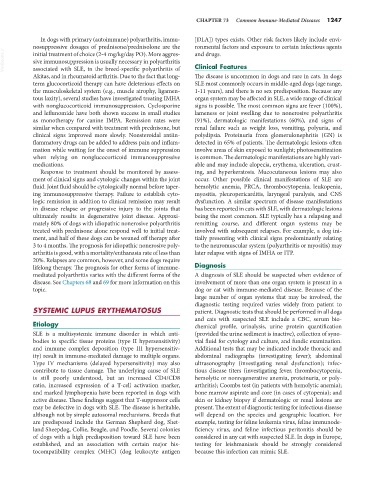Page 1275 - Small Animal Internal Medicine, 6th Edition
P. 1275
CHAPTER 73 Common Immune-Mediated Diseases 1247
In dogs with primary (autoimmune) polyarthritis, immu- [DLA]) types exists. Other risk factors likely include envi-
nosuppressive dosages of prednisone/prednisolone are the ronmental factors and exposure to certain infectious agents
VetBooks.ir initial treatment of choice (2-4 mg/kg/day PO). More aggres- and drugs.
sive immunosuppression is usually necessary in polyarthritis
Clinical Features
associated with SLE, in the breed-specific polyarthritis of
Akitas, and in rheumatoid arthritis. Due to the fact that long- The disease is uncommon in dogs and rare in cats. In dogs
term glucocorticoid therapy can have deleterious effects on SLE most commonly occurs in middle-aged dogs (age range,
the musculoskeletal system (e.g., muscle atrophy, ligamen- 1-11 years), and there is no sex predisposition. Because any
tous laxity), several studies have investigated treating IMHA organ system may be affected in SLE, a wide range of clinical
with nonglucocorticoid immunosuppression. Cyclosporine signs is possible. The most common signs are fever (100%),
and leflunomide have both shown success in small studies lameness or joint swelling due to nonerosive polyarthritis
as monotherapy for canine IMPA. Remission rates were (91%), dermatologic manifestations (60%), and signs of
similar when compared with treatment with prednisone, but renal failure such as weight loss, vomiting, polyuria, and
clinical signs improved more slowly. Nonsteroidal antiin- polydipsia. Proteinuria from glomerulonephritis (GN) is
flammatory drugs can be added to address pain and inflam- detected in 65% of patients. The dermatologic lesions often
mation while waiting for the onset of immune suppression involve areas of skin exposed to sunlight; photosensitization
when relying on nonglucocorticoid immunosuppressive is common. The dermatologic manifestations are highly vari-
medications. able and may include alopecia, erythema, ulceration, crust-
Response to treatment should be monitored by assess- ing, and hyperkeratosis. Mucocutaneous lesions may also
ment of clinical signs and cytologic changes within the joint occur. Other possible clinical manifestations of SLE are
fluid. Joint fluid should be cytologically normal before taper- hemolytic anemia, PRCA, thrombocytopenia, leukopenia,
ing immunosuppressive therapy. Failure to establish cyto- myositis, pleuropericarditis, laryngeal paralysis, and CNS
logic remission in addition to clinical remission may result dysfunction. A similar spectrum of disease manifestations
in disease relapse or progressive injury to the joints that has been reported in cats with SLE, with dermatologic lesions
ultimately results in degenerative joint disease. Approxi- being the most common. SLE typically has a relapsing and
mately 80% of dogs with idiopathic nonerosive polyarthritis remitting course, and different organ systems may be
treated with prednisone alone respond well to initial treat- involved with subsequent relapses. For example, a dog ini-
ment, and half of these dogs can be weaned off therapy after tially presenting with clinical signs predominantly relating
3 to 4 months. The prognosis for idiopathic nonerosive poly- to the neuromuscular system (polyarthritis or myositis) may
arthritis is good, with a mortality/euthanasia rate of less than later relapse with signs of IMHA or ITP.
20%. Relapses are common, however, and some dogs require
lifelong therapy. The prognosis for other forms of immune- Diagnosis
mediated polyarthritis varies with the different forms of the A diagnosis of SLE should be suspected when evidence of
disease. See Chapters 68 and 69 for more information on this involvement of more than one organ system is present in a
topic. dog or cat with immune-mediated disease. Because of the
large number of organ systems that may be involved, the
diagnostic testing required varies widely from patient to
SYSTEMIC LUPUS ERYTHEMATOSUS patient. Diagnostic tests that should be performed in all dogs
and cats with suspected SLE include a CBC, serum bio-
Etiology chemical profile, urinalysis, urine protein quantification
SLE is a multisystemic immune disorder in which anti- (provided the urine sediment is inactive), collection of syno-
bodies to specific tissue proteins (type II hypersensitivity) vial fluid for cytology and culture, and fundic examination.
and immune complex deposition (type III hypersensitiv- Additional tests that may be indicated include thoracic and
ity) result in immune-mediated damage to multiple organs. abdominal radiographs (investigating fever); abdominal
Type IV mechanisms (delayed hypersensitivity) may also ultrasonography (investigating renal dysfunction); infec-
contribute to tissue damage. The underlying cause of SLE tious disease titers (investigating fever, thrombocytopenia,
is still poorly understood, but an increased CD4/CD8 hemolytic or nonregenerative anemia, proteinuria, or poly-
ratio, increased expression of a T-cell activation marker, arthritis); Coombs test (in patients with hemolytic anemia);
and marked lymphopenia have been reported in dogs with bone marrow aspirate and core (in cases of cytopenia); and
active disease. These findings suggest that T-suppressor cells skin or kidney biopsy if dermatologic or renal lesions are
may be defective in dogs with SLE. The disease is heritable, present. The extent of diagnostic testing for infectious disease
although not by simple autosomal mechanisms. Breeds that will depend on the species and geographic location. For
are predisposed include the German Shepherd dog, Shet- example, testing for feline leukemia virus, feline immunode-
land Sheepdog, Collie, Beagle, and Poodle. Several colonies ficiency virus, and feline infectious peritonitis should be
of dogs with a high predisposition toward SLE have been considered in any cat with suspected SLE. In dogs in Europe,
established, and an association with certain major his- testing for leishmaniasis should be strongly considered
tocompatibility complex (MHC) (dog leukocyte antigen because this infection can mimic SLE.

